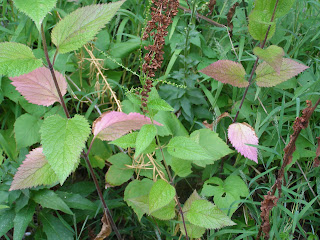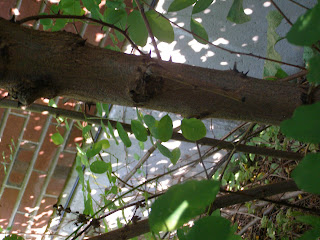 |
| Today, when I came to the garden, I was sad to see that someone had just dumped the pansies on the ground, probably to use the container. |
 |
| The fireworks weed's leaves are starting to turn color. Does anyone know the proper name of this plant? |
 |
| A cluster of calico aster shows the somewhat disheveled arrangement of the petals and the variable color of the flower centers, some yellow, others purple. |
 |
| Butter-and-eggs flowers bloom somewhat sparsely, as this is not the easiest place to grow! |
 |
| The sun shines through the leaves of the Tree-of-Heaven. |
 |
| Wild Lettuce buds promise to bloom soon. |
 |
| A thistle bud is starting to bloom. No tender buds these! |
 |
| The ragweed's green flowers promise misery to those who suffer from allergies. |
 |
| Seen close-up, the flower displays yellow pollon under the green "petal". |
 |
| This view shows the pollon-bearing stamens even more clearly. My fingers give an idea of scale. |
 |
| The Queen Anne's lace flowers are tightly curled as the seeds ripen. |
 |
| Seen up close, it appears that the Queen Anne''s lace seeds will travel as tiny burrs, hitching a ride to a new place. |
 |
| Delicate new hawthorn shoots unfurl and grow. |
 |
| Small "thorns" at the base of the multi-leaf stems are remnants of the bud scale. |
 |
| More Hawthorn forming more new leaves as the tree grows. |
 |
| True thorns can be seen coming off of the hawthorn's trunk. |
 |
| The evening primrose continues to produce its short-lived blooms and ripening seed pods. |
 |
| Primrose flowers may be small compared with the plant, but they add a welcome yellow accent. |
 |
| The pokeberry's clusters are long, numerous, and still green. The hawkweed's yellow flowers can be seen to the right. |
 |
| The pokeweed flowers are very white, each one with a tiny green center that will become a berry. |
 |
| The Horse-weed is in full bloom. |
 |
| Some Horse-weed plants have gone to seed, with fluffy seed-heads full of seeds ready to ride the wind. |
 |
| Seen up close, the horse-weed flowers look like tiny asters. A few have gone by and are developing fluff. |
 |
| Here are the flowering branches springing forth from the neat rosettes seen earlier. |
 |
| Hawk-weed flowers look a bit like dandelions and wild lettuce. |
 |
| Goldenrod can be seen in yellow bud and fullflower |
 |
| Wild morning glory flowers are very attractive to bees. |
 |
| Bee on calico aster |
 |
| Developing mugwort is still seen, but late as it is, has little chance. |
 |
| Mugwort buds will develop into tiny flowers that appear to have no petals. |
 |
| The calico aster has branched out fully, and is starting to produce flowers. |
 |
| The burdock flowers have bloomed, and are now transforming themselves into burrs. |
 |
| The nimblewill grass is forming seed, |
 |
| Raspberry leaves are green and non-committal. |
 |
| I must admit that this photo is not in the wild garden, but in a parking lot nearby. The intent is to show wild morning glory climbing high at a nearby site. |
 |
| This bindweed flower shows just the slightest hint of color. |
 |
| Bindweed leaves are seen throughout the garden, as the vine twists and turns among the other plants. |
 |
| Asian dayflower leaves are starting to show signs of insect damage. |
 |
| Asian dayflowers bloom early in the day and, like only a few other flowers are true blue. |












No comments:
Post a Comment